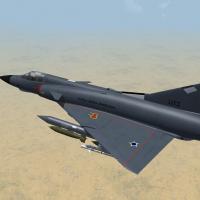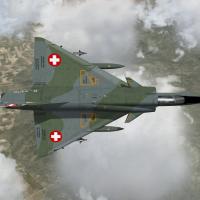
Mirage IIIRS Swiss Air Force
Install - Need Update July 2012 and DLC Mirage IIIO
The Swiss Mirages are equipped with RWS, chaff & flare dispensers. Avionics differed as well, with the most prominent difference being that the Thomson-CSF Cyrano II radar was replaced by Hughes TARAN-18 system, giving the Mirage IIIS compatibility with the Hughes AIM-4 Falcon AAM. Also the Mirage IIIS had the wiring to carry a Swiss-built nuclear bomb or French nuclear bomb. The Swiss nuclear bomb was stopped in the preproduction stage and Switzerland did not purchase the French-made bomb. The Mirage IIIS had an integral fuel tank under the aft belly; this fuel tank could be removed and replaced with an adapter of the same shape. This adapter housed a SEPR rocket engine with its liquid fuel tanks. With the SEPR rocket, the Mirage IIIS easily reached altitudes of 20,000 m. The rocket fuel was very hazardous and highly toxic, so the SEPR rocket was not used very often. The Mirage IIIRS could also carry a photo-reconnaissance centerline pod and an integral fuel tank under the aft belly; this carried a smaller fuel load but allowed a back looking film camera to be added. In the early 1990s, the 30 surviving Swiss Mirage IIIS interceptors were put through an upgrade program, which included fitting them with fixed canards and updated avionics. The Mirage IIIS were phased out of service in 1999. The remaining Mirage IIIRS, BS and DS were taken out of service in 2003
Animed Cockpit - SHFT + 1
Modelo - TK (Mirage IIIO)
Texture - Ludo, Denis Oliveira, Coupi
mod - Denis Oliveira
DATA.INI - Coupi
Decals - Coupi
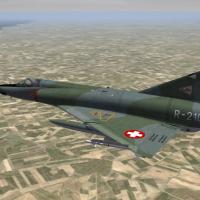
Mirage IIIRS Swiss Air Force (EARLY)
Install - Need Update July 2012 and DLC Mirage IIIO
The Swiss Mirages are equipped with RWS, chaff & flare dispensers. Avionics differed as well, with the most prominent difference being that the Thomson-CSF Cyrano II radar was replaced by Hughes TARAN-18 system, giving the Mirage IIIS compatibility with the Hughes AIM-4 Falcon AAM. Also the Mirage IIIS had the wiring to carry a Swiss-built nuclear bomb or French nuclear bomb. The Swiss nuclear bomb was stopped in the preproduction stage and Switzerland did not purchase the French-made bomb. The Mirage IIIS had an integral fuel tank under the aft belly; this fuel tank could be removed and replaced with an adapter of the same shape. This adapter housed a SEPR rocket engine with its liquid fuel tanks. With the SEPR rocket, the Mirage IIIS easily reached altitudes of 20,000 m. The rocket fuel was very hazardous and highly toxic, so the SEPR rocket was not used very often. The Mirage IIIRS could also carry a photo-reconnaissance centerline pod and an integral fuel tank under the aft belly; this carried a smaller fuel load but allowed a back looking film camera to be added. In the early 1990s, the 30 surviving Swiss Mirage IIIS interceptors were put through an upgrade program, which included fitting them with fixed canards and updated avionics. The Mirage IIIS were phased out of service in 1999. The remaining Mirage IIIRS, BS and DS were taken out of service in 2003
Animed Cockpit - SHFT + 1
Modelo - TK (Mirage IIIO)
Texture - Ludo, Denis Oliveira,Coupi
mod - Denis Oliveira
DATA.INI - Coupi
Decals - Coupi

Mirage IIIS Swiss Air Force
(two versions)
Install - Need Update July 2012 and DLC Mirage IIIO
In 1961, Switzerland bought a single Mirage IIIC from France. This Mirage IIIC was used as development aircraft. The Swiss Mirages were built in Switzerland by F+W Emmen (today RUAG ) (the federal government aircraft factory in Emmen) as the Mirage IIIS. Australia too, bought, one French-made in preparation for licensed production. Cost overruns during the Swiss production led to the so-called "Mirage affair". In all, 36 Mirage IIIS interceptors were built with strengthened wings, airframe, and undercarriage. The Swiss Air Force required performance comparable to those of carrier based planes; the airframes were reinforced so the aircraft could be moved by lifting them over other aircraft with a crane, as in the Aircraft cavern in the mountains that Swiss Air Force uses as bunkers, offer very little space to maneuver parked aircraft. Also, the strengthened frames allowed for JATO assisted takeoffs. The main differences to the standard Mirage III were as follows:
New wiring of avionics with U.S. electronics
Changed cockpit design with gray instead of black panels
New U.S. radar, TARAN-18 from Hughes
Use of HM-55S "Falcon" (Swiss designation of the from SAAB in Licence built Robot 27 (Rb27) which is similar to the Hughes AIM-26 "Falcon")
Radar warning receiver (RWR) on both wingtips and on the back of the rudder
Strengthened structure for use of JATO-Rockets
Retractable nosecone and lengthened nosewhlle leg for storing in underground air base
Four lifting points for moving aircraft in underground caverns with a crane
Bay at the fin with a SEPR rocket engine to double the velocity for short time or climb to 20 000 m (60 000 ft)
US TRACOR AN/ALE-40 chaff/flare dispenser at the back under the end of the engine (fitted with the upgrade 1988)
Canards designed and produced by RUAG Aerospace(fitted with the upgrade 1988)
New Martin-Baker ejection-seat (fitted with the upgrade 1988)
The Swiss Mirages are equipped with RWS, chaff & flare dispensers. Avionics differed as well, with the most prominent difference being that the Thomson-CSF Cyrano II radar was replaced by Hughes TARAN-18 system, giving the Mirage IIIS compatibility with the Hughes AIM-4 Falcon AAM. Also the Mirage IIIS had the wiring to carry a Swiss-built nuclear bomb or French nuclear bomb. The Swiss nuclear bomb was stopped in the preproduction stage and Switzerland did not purchase the French-made bomb. The Mirage IIIS had an integral fuel tank under the aft belly; this fuel tank could be removed and replaced with an adapter of the same shape. This adapter housed a SEPR rocket engine with its liquid fuel tanks. With the SEPR rocket, the Mirage IIIS easily reached altitudes of 20,000 m. The rocket fuel was very hazardous and highly toxic, so the SEPR rocket was not used very often. The Mirage IIIRS could also carry a photo-reconnaissance centerline pod and an integral fuel tank under the aft belly; this carried a smaller fuel load but allowed a back looking film camera to be added. In the early 1990s, the 30 surviving Swiss Mirage IIIS interceptors were put through an upgrade program, which included fitting them with fixed canards and updated avionics. The Mirage IIIS were phased out of service in 1999. The remaining Mirage IIIRS, BS and DS were taken out of service in 2003.
________________________________________________________________________________________________________________
Animed Cockpit - SHFT + 1
Texture - Denis Oliveira
Texture Early Version - Coupi
Template Texture - Ludo
3D mod - Denis Oliveira
Decals - Coupi
Data ini - Coupi, Denis Oliveira
Cockpit and Avioncs ini - Coupi, Denis Oliveira
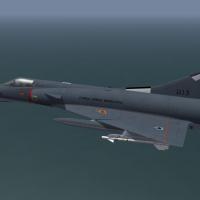
F-103 Mirage IIIEBR Brazilian Air Force
Version 2
Install - Need Update July 2012 and DLC Mirage IIIO
The F-103 Mirage IIIEBR represented a tremendous leap to the Brazilian Air Force, being over thirty years of service and more than 65,000 flying hours.
The versions of Mirage III acquired by FAB were developed primarily for air defense missions, but keep some capacity to act as platforms for ground attack.
The engine was a SNECMA ATAR 09C, whose maximum thrust with afterburning reached 13,900 pounds (6305 kg), leading the aircraft a maximum speed of Mach 2.2 (2,350 km / h).
The fire control system was based on radar Thomson-CSF Cyrano II, which originally operated the integrated air-to-air missile infrared Matra R530, later replaced by Israeli missile Python III.
As arms fixed, the aircraft was equipped with two 30 mm DEFA. For navigation, the Mirage III FAB type Doppler systems used. In the early '90s, the FAB joined the Squadron's missions Jaguar air-ground attack, starting to use free-fall bombs and rocket launchers.
(Portuguese)
O F-103 Mirage IIIEBR representou um tremendo salto para a Força Aérea Brasileira, ficando mais de trinta anos de serviço e voando mais de 65.000 horas.
Os Mirage III das versões adquiridas pela FAB foram desenvolvidas primariamente para missões de defesa aérea, embora mantivessem alguma capacidade de atuar como plataformas de ataque ao solo.
O motor era um SNECMA ATAR 09C, cujo empuxo máximo com pós-combustão alcançava 13.900 libras (6.305 kg), levando a aeronave a velocidade máxima de Mach 2,2 (2.350 km/h).
O sistema de controle de fogo era baseado no radar Thomson-CSF Cyrano II, que originalmente operava integrado ao míssil ar-ar infra-vermelho Matra R530, depois substituído pelo míssil israelense Python III.
Como armamento fixo, a aeronave era dotada de dois canhões DEFA de 30 mm. Para navegação, os Mirage III da FAB utilizavam sistemas tipo Doppler. No inícios dos anos 90, a FAB incorporou ao Esquadrão Jaguar as missões de ataque ar-solo, passando a utilizar bombas de queda livre e lançadores de foguetes.
Animed Cockpit - SHFT + 1
Modelo - TK (Mirage IIIO)
Texture - TK, Denis Oliveira
mod - Denis Oliveira
Decals - Coupi
Data.ini - Denis Oliveira, Coupi
F-103 Mirage IIIEBR Brazilian Air Force
Modelo - TK (MIrage IIIO)
Texture - TK, Denis Oliveira
Canard - Denis Oliveira
Install - Need Update July 2012 and DLC Mirage IIIO
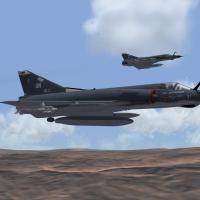
F-103 Mirage IIIEBR Brazilian Air Force (refuelling probe)
Install - Need Update July 2012, DLC Mirage IIIO and DLC Mirage IIIEL
The F-103 Mirage IIIEBR represented a tremendous leap to the Brazilian Air Force, being over thirty years of service and more than 65,000 flying hours.
The versions of Mirage III acquired by FAB were developed primarily for air defense missions, but keep some capacity to act as platforms for ground attack.
The engine was a SNECMA ATAR 09C, whose maximum thrust with afterburning reached 13,900 pounds (6305 kg), leading the aircraft a maximum speed of Mach 2.2 (2,350 km / h).
The fire control system was based on radar Thomson-CSF Cyrano II, which originally operated the integrated air-to-air missile infrared Matra R530, later replaced by Israeli missile Python III.
As arms fixed, the aircraft was equipped with two 30 mm DEFA. For navigation, the Mirage III FAB type Doppler systems used. In the early '90s, the FAB joined the Squadron's missions Jaguar air-ground attack, starting to use free-fall bombs and rocket launchers.
Upgrading the F-103
In 1989 all F-103s entered a limited upgrade program. The upgrade consisted of the installation of canards and some minor mechanical and structural modifications. In 1991/1992 one F-103E (FAB 4929) received a refuelling probe installation and on April 22, 1992, the aircraft made its first refuelling contact with a KC-130H of the 1º/1º GT. The modified F-103 flew until 1993 but was then retired and the program to install refuelling probes on all Mirage fleet was cancelled.(The number FAB-4928, FAB-4930 and FAB-4931 are fictitious!)
(Portuguese)__________________________________________________________________________________
O F-103 Mirage IIIEBR representou um tremendo salto para a Força Aérea Brasileira, ficando mais de trinta anos de serviço e voando mais de 65.000 horas.
Os Mirage III das versões adquiridas pela FAB foram desenvolvidas primariamente para missões de defesa aérea, embora mantivessem alguma capacidade de atuar como plataformas de ataque ao solo.
O motor era um SNECMA ATAR 09C, cujo empuxo máximo com pós-combustão alcançava 13.900 libras (6.305 kg), levando a aeronave a velocidade máxima de Mach 2,2 (2.350 km/h).
O sistema de controle de fogo era baseado no radar Thomson-CSF Cyrano II, que originalmente operava integrado ao míssil ar-ar infra-vermelho Matra R530, depois substituído pelo míssil israelense Python III.
Como armamento fixo, a aeronave era dotada de dois canhões DEFA de 30 mm. Para navegação, os Mirage III da FAB utilizavam sistemas tipo Doppler. No inícios dos anos 90, a FAB incorporou ao Esquadrão Jaguar as missões de ataque ar-solo, passando a utilizar bombas de queda livre e lançadores de foguetes.
Atualizando o F-103
Em 1989, todos os F-103 entrou em um programa de atualização limitado. O melhoramento consiste na instalação de canards e algumas modificações mecânicas e estruturais menores. Em 1991/1992 um F-103E (FAB 4929), recebeu uma instalação de sonda de reabastecimento e, em 22 de abril de 1992, a aeronave fez o seu primeiro contato com um reabastecimento KC-130H do 1 º / 1 º GT. A modificação F-103 voaram até 1993, mas foi então aposentado e o programa para instalar sondas de reabastecimento em toda frota de Mirage foi cancelado. (Os número FAB-4928, FAB-4930 e FAB-4931 são fictícios !)
Animed Cockpit - SHFT + 1
Modelo - TK (Mirage IIIO)
Texture - TK, Denis Oliveira
mod - Denis Oliveira
Decals - Denis Oliveira
Data.ini - Denis Oliveira, Coupi
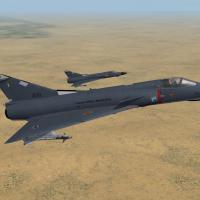
F-103 Mirage IIIEBR Brazilian Air Force
Version 3
(two versions included)
Install - Need Update July 2012, DLC Mirage IIIO and DLC Mirage IIIEL
The F-103 Mirage IIIEBR represented a tremendous leap to the Brazilian Air Force, being over thirty years of service and more than 65,000 flying hours.
The versions of Mirage III acquired by FAB were developed primarily for air defense missions, but keep some capacity to act as platforms for ground attack.
The engine was a SNECMA ATAR 09C, whose maximum thrust with afterburning reached 13,900 pounds (6305 kg), leading the aircraft a maximum speed of Mach 2.2 (2,350 km / h).
The fire control system was based on radar Thomson-CSF Cyrano II, which originally operated the integrated air-to-air missile infrared Matra R530, later replaced by Israeli missile Python III.
As arms fixed, the aircraft was equipped with two 30 mm DEFA. For navigation, the Mirage III FAB type Doppler systems used. In the early '90s, the FAB joined the Squadron's missions Jaguar air-ground attack, starting to use free-fall bombs and rocket launchers.
(Portuguese)
O F-103 Mirage IIIEBR representou um tremendo salto para a Força Aérea Brasileira, ficando mais de trinta anos de serviço e voando mais de 65.000 horas.
Os Mirage III das versões adquiridas pela FAB foram desenvolvidas primariamente para missões de defesa aérea, embora mantivessem alguma capacidade de atuar como plataformas de ataque ao solo.
O motor era um SNECMA ATAR 09C, cujo empuxo máximo com pós-combustão alcançava 13.900 libras (6.305 kg), levando a aeronave a velocidade máxima de Mach 2,2 (2.350 km/h).
O sistema de controle de fogo era baseado no radar Thomson-CSF Cyrano II, que originalmente operava integrado ao míssil ar-ar infra-vermelho Matra R530, depois substituído pelo míssil israelense Python III.
Como armamento fixo, a aeronave era dotada de dois canhões DEFA de 30 mm. Para navegação, os Mirage III da FAB utilizavam sistemas tipo Doppler. No inícios dos anos 90, a FAB incorporou ao Esquadrão Jaguar as missões de ataque ar-solo, passando a utilizar bombas de queda livre e lançadores de foguetes.
Animed Cockpit - SHFT + 1
Modelo - TK (Mirage IIIO)
Texture - TK, Denis Oliveira
mod - Denis Oliveira
Decals - Coupi
Data.ini - Denis Oliveira, Coupi

The Sud Aviation (SNCASO) S.O. 4050 Vautour II was a French bomber, interceptor, and attack aircraft used by the Armée de l'Air (AdA).
Vautour is the French word for vulture.
S.O. 4050 Vautour IIN: Two-seat, all-weather interceptor with DRAC-25AI or DRAC-32AI radar in nose, pilot and co-pilot in tandem seats, armed with cannon, air-to-air missiles, and (theoretically) unguided rockets. The designation was later changed to II-1N.
France (70 planes), Israel (7+1 planes sold)
What's in:
- 1 New IDF Blue Camo skin
- 2 Reworked IDF Silver/Camo Skins
- 10 New historical AdA silver skin with proper decalset
- cockpit, pilot
- Screens and images
Credits:
- Model Veltro2K
- F-86D Cockpit: Sabre dog team
- IAF 50s/60s Pilot: Wrench & PappyCheckSix
- Original editions: Wrench & Eburger68
- original IDF silver skin Elek, late camo Veltro (?)
- new ones, upgrades and new decals me
Install:
all in main mod folder.
Enjoy
@paulopanz
PS: These Vautours are mainly for Starfighter2 who asked me long time ago. At last we have them my friend.





